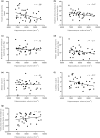Increased stressor-evoked cardiovascular reactivity is associated with reduced amygdala and hippocampus volume
- PMID: 30132921
- PMCID: PMC6849591
- DOI: 10.1111/psyp.13277
Increased stressor-evoked cardiovascular reactivity is associated with reduced amygdala and hippocampus volume
Abstract
Exaggerated cardiovascular reactivity to acute psychological stress is associated with an increased risk of developing cardiovascular disease. The amygdala and hippocampus have been implicated in centrally mediating stressor-evoked cardiovascular reactivity. However, little is known about the associations of amygdala and hippocampus morphology with stressor-evoked cardiovascular reactivity. Forty (Mage = 19.05, SD = 0.22 years) healthy young women completed two separate testing sessions. Session 1 assessed multiple parameters of cardiovascular physiology at rest and during a validated psychological stress task (Paced Auditory Serial Addition Test), using electrocardiography, Doppler echocardiography, and blood pressure monitoring. In Session 2, 1 year later, structural MRI was conducted. Brain structural volumes were computed using automated segmentation methods. Regression analyses, following Benjamini-Hochberg correction, showed that greater heart rate and cardiac output reactivity were associated with reduced amygdala and hippocampus gray matter volume. Systolic blood pressure reactivity was associated with reduced hippocampus volume. In contrast, no associations between diastolic blood pressure, mean arterial blood pressure, stroke volume, or total peripheral resistance reactivity with amygdala or hippocampus volumes were apparent. Comparison analyses examining insula volume found no significant associations. Some indicators of greater stressor-evoked cardiovascular reactivity associate with reduced amygdala and hippocampus gray matter volume, but the mechanisms of this association warrant further study.
Keywords: amygdala; brain morphology; hippocampus; individual differences; magnetic resonance imaging; psychological stress; stressor-evoked cardiovascular reactivity.
© 2018 The Authors. Psychophysiology published by Wiley Periodicals, Inc. on behalf of Society for Psychophysiological Research.
Figures



Similar articles
-
Individual differences in stressor-evoked blood pressure reactivity vary with activation, volume, and functional connectivity of the amygdala.J Neurosci. 2008 Jan 23;28(4):990-9. doi: 10.1523/JNEUROSCI.3606-07.2008. J Neurosci. 2008. PMID: 18216206 Free PMC article.
-
A Brain Phenotype for Stressor-Evoked Blood Pressure Reactivity.J Am Heart Assoc. 2017 Aug 23;6(9):e006053. doi: 10.1161/JAHA.117.006053. J Am Heart Assoc. 2017. PMID: 28835356 Free PMC article.
-
Cynical hostility relates to a lack of habituation of the cardiovascular response to repeated acute stress.Psychophysiology. 2020 Dec;57(12):e13681. doi: 10.1111/psyp.13681. Epub 2020 Sep 13. Psychophysiology. 2020. PMID: 32920855
-
A review of neuroimaging studies of stressor-evoked blood pressure reactivity: emerging evidence for a brain-body pathway to coronary heart disease risk.Neuroimage. 2009 Sep;47(3):922-36. doi: 10.1016/j.neuroimage.2009.04.073. Epub 2009 May 4. Neuroimage. 2009. PMID: 19410652 Free PMC article. Review.
-
Cardiovascular and autonomic reactivity to psychological stress: Neurophysiological substrates and links to cardiovascular disease.Auton Neurosci. 2017 Nov;207:2-9. doi: 10.1016/j.autneu.2017.03.003. Epub 2017 Mar 16. Auton Neurosci. 2017. PMID: 28391987 Free PMC article. Review.
Cited by
-
Neurobiological mechanisms of early life adversity, blunted stress reactivity and risk for addiction.Neuropharmacology. 2021 May 1;188:108519. doi: 10.1016/j.neuropharm.2021.108519. Epub 2021 Mar 10. Neuropharmacology. 2021. PMID: 33711348 Free PMC article. Review.
-
Investigating the Protective Role of Mastery Imagery Ability in Buffering Debilitative Stress Responses.Front Psychol. 2019 Jul 24;10:1657. doi: 10.3389/fpsyg.2019.01657. eCollection 2019. Front Psychol. 2019. PMID: 31396128 Free PMC article.
-
Higher Rightward Laterality of the Hippocampal Tail and Its Association with Early Trauma in Panic Disorder.Clin Psychopharmacol Neurosci. 2020 May 31;18(2):311-321. doi: 10.9758/cpn.2020.18.2.311. Clin Psychopharmacol Neurosci. 2020. PMID: 32329311 Free PMC article.
-
Parental Education, Household Income, Race, and Children's Working Memory: Complexity of the Effects.Brain Sci. 2020 Dec 7;10(12):950. doi: 10.3390/brainsci10120950. Brain Sci. 2020. PMID: 33297546 Free PMC article.
-
Differences in the Course of Physiological Functions and in Subjective Evaluations in Connection With Listening to the Sound of a Chainsaw and to the Sounds of a Forest.Front Psychol. 2022 Feb 21;13:775173. doi: 10.3389/fpsyg.2022.775173. eCollection 2022. Front Psychol. 2022. PMID: 35265000 Free PMC article.
References
-
- Benjamini, Y. , & Hochberg, Y. (1995). Controlling the false discovery rate: A practical and powerful approach to multiple testing. Journal of the Royal Statistical Society, 57(1), 289–300.
Publication types
MeSH terms
LinkOut - more resources
Full Text Sources
Other Literature Sources
Medical

